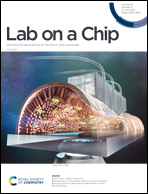Magnetic delivery and ultrasound-responsive release of chelating microcapsules for selective removal of urolithiasis†
Abstract
A novel urolithiasis treatment in which a chelating solution encapsulated in poly(lactic-co-glycolic acid); PLGA-based microcapsules was delivered magnetically to specific urolithiasis sites and then subjected to ultrasound (US) to release the chelating solution and dissolve the stones. Using a double-droplet microfluidics method, a hexametaphosphate (HMP) chelating solution was encapsulated in an Fe3O4 nanoparticle (Fe3O4 NP)-loaded PLGA polymer shell with a thickness of <15 μm, forming homogenous microcapsules of 319 ± 14 μm in size. The obtained microcapsules (HMP/Fe3O4@PLGA) exhibited efficient magnetic mobility and US-responsive solution release. Moreover, in a Ψ-shaped flow chip, selective delivery of HMP from the microcapsules was achieved with high magnetic delivery efficiency (>90%), and an effective removal efficacy (>95%, 7 repeat cycles) of artificial calcium oxalate (5 mm in size) via a chelating effect. Eventually, the potential removal of urolithiasis in the body was verified using a PDMS-based kidney urinary flow-imitating chip with a human kidney stone (CaOx 100%, 5–7 mm in size) located in the minor calyx under an artificial urine counter flow (0.5 mL min−1). In the end, more than 50% of the stone, even in surgically tricky regions, was removed by 10 repeated treatments. Therefore, the selective approach of stone-dissolution capsules will help to develop alternative urolithiasis treatments to conventional surgical and systemic dissolution approaches.



 Please wait while we load your content...
Please wait while we load your content...